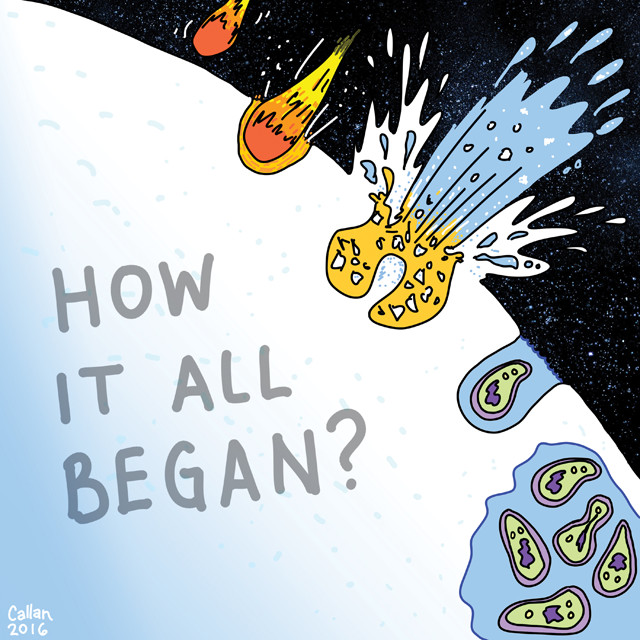
by Jacob Haqq-Misra Tuesday, September 20, 2016

Conventional wisdom suggests that life on Earth emerged on a hothouse, but what if it instead emerged during a Snowball Earth? Credit: Callan Bentley.
The Hadean Eon, the first 500 million years of Earth’s history, was a harsh and violent time. After Earth formed 4.6 billion years ago, the leftover debris in the solar system bombarded Earth’s surface. It is thought that the moon formed during this turbulent period, coalescing out of the dust from a collision between Earth and a larger planetoid, perhaps the size of Mars. Earth’s molten surface was beginning to take shape during this period, and the onset of volcanism helped develop the atmosphere. Geologic evidence suggests temperatures were smoking hot. Somewhere toward the end of the hell-like Hadean, and the more quiescent Archean Eon that followed, life emerged on Earth. But what if life emerged not during a hothouse, but instead during a global icehouse — a Snowball Earth?
Geologic evidence suggests the Hadean was quite hot, but still cool enough for liquid oceans to exist without boiling away. Evidence of liquid water during the eon comes from zircon crystals in Earth’s oldest-known rocks in the Jack Hills of Western Australia, dating to about 4.3 billion years ago. Zircon crystals provide a clue to environmental conditions during formation; the amount of titanium in the Jack Hills zircons suggests temperatures during the Hadean were at least warm enough to melt ice.
These warm temperatures are thought to have occurred despite the sun being fainter during the Hadean — about 30 percent less luminous than today – which leads to the aptly named “faint young sun paradox.” Stellar evolution models predict that a star’s core contracts with age as hydrogen is fused into denser helium, which causes its energy output to increase with time. The expected lower amount of sunlight during the Hadean implies that early Earth should have been frozen, not hot. Reconciling the predictions of a faint young sun with geologic evidence of a warm Hadean climate is the essence of the paradox.
Why did Earth not freeze over? The most common suggestion is that greenhouse gas concentrations were much higher during the Hadean. Carl Sagan and other astronomers in the 1970s speculated that ammonia might have helped to keep early Earth warm, but subsequent studies have shown that atmospheric ammonia would be readily destroyed by photochemical reactions. Carbon dioxide remains the most likely possibility; it could have been delivered by meteorites and other impactors and, perhaps, from increased volcanic activity. Although direct evidence of the Hadean atmosphere is scant, this idea of a carbon dioxide-rich Hadean atmosphere remains the dominant paradigm in earth science today.
However, dense carbon dioxide atmospheres are poor environments for the processes of prebiotic synthesis that can create organic compounds. Would life have been likely to emerge from a hot and dense carbon dioxide atmosphere where the precursors to life are rare? Another possibility challenges the orthodox view altogether. What if the Hadean were cold, and the evidence from zircons and other sources indicated only temporary or local warm episodes?
As the faint young sun paradox predicts, early Earth should have been frozen, and the requirement of a dense carbon dioxide veil is only a theoretical solution to the paradox. But Earth has frozen into such a Snowball state before — at least once, about 650 million years ago in the Neoproterozoic, and likely several other times as well — and each time, life managed to survive. Thin ice, or open water, at the tropics, isolated landlocked oases, and radiogenic heating from the core allowed Earth’s biota to survive these episodes of global glaciation. A cold Hadean is not necessarily an impediment to life.
This leads us to a very different view of Earth’s climate during the Hadean. During this phase of heavy bombardment, catastrophic impacts, capable of melting an ice-covered ocean, were possible. An object with a diameter of 100 kilometers would be capable of melting the entire ice cover on an ocean. Smaller objects about 10 kilometers in diameter (such as the one that contributed to the extinction of the dinosaurs) could also have punctured holes in the ice layer, helping to release trapped greenhouse gases and exacerbate refreezing. Crater formation rates on the moon suggest that several ice-melting impactors could have struck Earth during the Hadean. The Hadean climate may have been characterized by periodic cycles of global glaciation and melting, triggered by impacts.
Did life emerge on a planet trapped in a freeze-thaw cycle? Impactors are often thought to be a nuisance to the emergence of life, inhibiting the delicate biological processes beginning to take shape. But perhaps catastrophic impacts were exactly what was needed to provide Earth with a periodic burst of energy that thawed the ice-covered oceans and allowed for new creative experiments in biochemistry. Maybe life first developed during an impact-driven thaw. Maybe life arose twice or more in Earth’s history, only to be wiped out again by an impending freeze. What we do know is that life eventually emerged from the Hadean environment to transform the planet. A Snowball Hadean provides another possible start to the story.
© 2008-2021. All rights reserved. Any copying, redistribution or retransmission of any of the contents of this service without the expressed written permission of the American Geosciences Institute is expressly prohibited. Click here for all copyright requests.